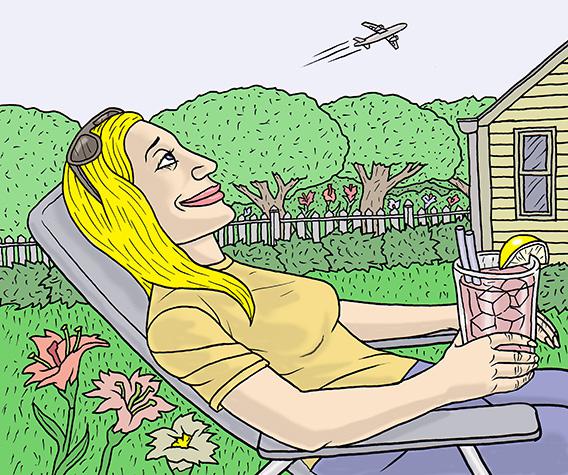I would never commute to work in a Hummer, leave the house with all the lights on, or send my recyclables to a landfill, and yet, for most of my life, I proudly engaged in an activity far worse for the environment than any of these other eco-sins—I jetted around the world.
It’s not that I ever thought flying was environmentally harmless, but I’d never appreciated the magnitude of its destructiveness. It seemed to me that traveling in a jumbo jet packed with passengers was sort of like riding a bus through the sky—public transportation is good, right?
The numbers told me otherwise. A nonstop flight from San Francisco to New York puts you on the hook for 2.23 tons of carbon dioxide. Fly first class, and the extra space you occupy bumps you to 5.59 tons—more than twice the 2.2 tons you’d emit driving a midrange car 7,500 miles. It’s not just aviation’s carbon emissions that make it so bad for the climate, it’s also factors like vapor trails and ozone as well as where a jet’s emissions occur—in a sensitive part of the atmosphere where their effects become magnified. Scientists call this effect “radiative forcing” and calculations that don’t include it can make flying seem deceptively benign. Don’t be fooled: Every time you get on an airplane, you’re helping to shove a Bangladeshi’s home under water.
Yet despite the danger, flying rarely provokes the kind of environmental shame that driving a Hummer or running the washer and dryer with a single item might. It’s hard to say exactly why, but I have a theory—it’s easy to act like an environmentalist when it means buying cool new stuff like reusable grocery bags, a high-efficiency washer, or a hybrid car. When doing the green thing requires actual sacrifice or a substantial change in lifestyle, well, that’s where most of us draw the line.
I’m as guilty as anyone. As the daughter of a pilot, I’ve spent much of my life at 30,000 feet. But a few years ago, I did the math and discovered that the flights I’d already taken had pumped out more greenhouse emissions than a bevy of countries produce in several years. The reality is stark—frequent fliers like me are driving climate change that will disproportionately affect people in developing countries—most of whom will never fly.
With this sobering realization, I decided to try staying put for a while. For a year, I would remain within 100 miles of my house. I embarked on the plan believing that a year without travel would feel like a tremendous sacrifice, one that I could force myself to endure for 12 months to prove that I could.
Yet, about a month in, I began to wonder what the hell I’d found so appealing about travel in the first place. I knew that I wouldn’t miss the parts that so obviously suck—the blaring television sets in the waiting lounges, the TSA pat downs, the screaming baby seated behind me in seat 43 E, or the captain’s announcement that we’re No. 19 for takeoff. What shocked me was just how much less frantic and overextended I felt when I wasn’t constantly preparing for or recovering another long haul from home. Until then, I’d never fully appreciated just how much travel had disrupted my daily routines and prevented me from ever feeling caught up on anything. Knowing exactly where I’d be in a week or three months or 10—without having to refer to my calendar—gave me a tremendous sense of grounding and calm.
I began to realize that my time on the road didn’t just give me exposure to new ideas and exotic cultures, it robbed me of something important—a connection to home. Every day I spent visiting tourist spots or lugging myself to interchangeable conference rooms was one that I was absent from my true life—the one that matters most. When I knew that I’d be here next weekend (and dozens after that), I could commit to local outings, events, and volunteer projects that gave me a stake in my community and connection to people with a shared purpose. Over the course of the year, my place became a part of my identity, an answer to the question, “Who am I?”
Staying put helped me understand that contentment can only come from making the best of what’s around me, rather than constantly seeking the perfect location or set of circumstances. By committing to my corner of the world, I was letting go of elsewhere, and that felt liberating, not constrictive. It’s a lesson that Benedictine monks have long understood with their vow of stability—a promise to remain in the same monastery for life. There is no perfect place, and to keep seeking it is to doom yourself to disappointment.
As I finished my year at home, I found myself irrevocably changed. Before I started, my default answer to travel was always “yes,” but now I find myself unable and uninterested in returning to that mindset. I still travel occasionally, but I do it regionally (in my fuel efficient car) whenever possible and take care to limit my trips.
If you’re anything like I was, you may be thinking that you could never give up travel, but I’m confident that most frequent fliers would be happier if they tried. If you won’t do it for the planet or its most vulnerable inhabitants, do it for yourself. Staying home will fatten your wallet, cut your stress, and help you become more present in your own life. Most of all, giving up the relentless pursuit of elsewhere gives you a chance to find what you’re seeking at home.
